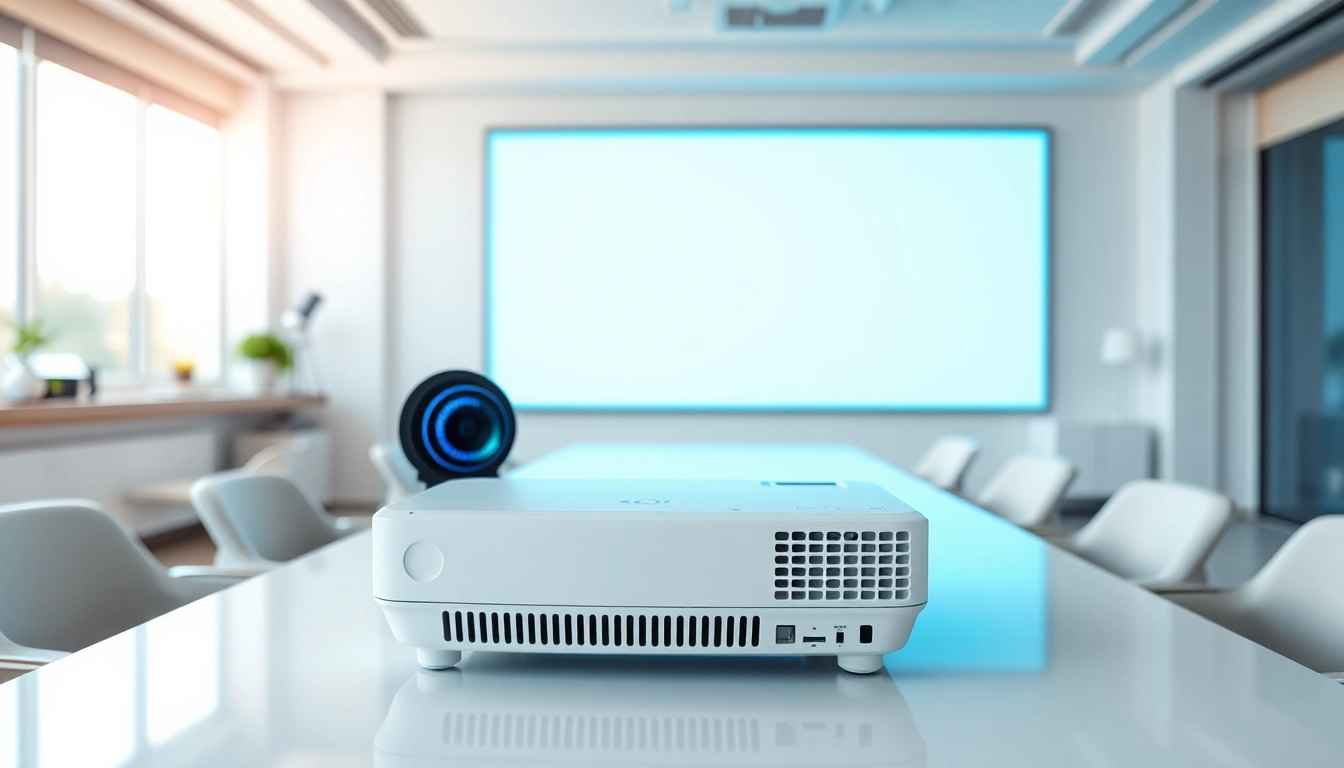Understanding Different Types of Projector
When selecting a Projector, it’s crucial to understand the various types available on the market. Each type offers unique features tailored to different applications, environments, and user needs. This section delves into digital projectors and compares the three primary technologies—LED, LCD, and DLP—highlighting their key features and benefits.
Digital Projector: Key Features and Benefits
Digital projectors have transformed the way we present information by delivering high-quality images and seamless connectivity with various devices. They typically offer a range of features designed to enhance the viewing experience. Here are some key features:
- High Resolution: Digital projectors are available in various resolutions, including HD (720p), Full HD (1080p), and 4K, ensuring crystal-clear images.
- Brightness: Measured in lumens, the brightness of a projector is crucial for visibility in different lighting conditions. Higher lumens correspond to brighter images, making them suitable for well-lit environments.
- Portability: Many digital projectors are compact and lightweight, ideal for mobile presentations or home use, allowing for easy transport and setup.
- Connectivity Options: Modern projectors support a multitude of connection types, including HDMI, USB, and wireless options to connect to laptops, tablets, or smartphones effortlessly.
- Enhanced Color Accuracy: Digital projectors often utilize advanced color technology for true-to-life image reproduction, crucial for applications like graphic design, photography, and video editing.
These features make digital projectors a versatile solution for both personal and professional use, catering to diverse needs from home theaters to business presentations.
Lumen Ratings and Projector Performance
Lumen ratings play a critical role in determining a projector’s performance, influencing image clarity and visibility. Understanding how lumens relate to your projection environment can significantly impact your viewing experience:
- Brightness Needs: Higher lumen ratings are necessary for brighter environments. For instance, a projector with at least 2500 lumens is recommended for well-lit meeting rooms, while around 1000 lumens may suffice for darker home cinema settings.
- Contrast Ratio: Alongside luminosity, contrast ratio impacts how well a projector distinguishes between dark and light images. Higher contrast ratios yield more dynamic and lifelike visuals.
- Set-Up and Distance: The projected image’s brightness is also influenced by the distance from the projector to the screen, as light disperses over distance.
By recognizing how lumen ratings affect performance, users can better match a projector to their specific needs and environments.
Comparing LED, LCD, and DLP Projector Technologies
Various technologies underpin digital projectors, each with advantages and potential drawbacks:
- LED Projectors: These projectors use light-emitting diodes as their light source, offering longer lifespans and energy efficiency. They are compact and capable of producing vibrant colors, but historically may offer lower brightness compared to other types.
- LCD Projectors: Liquid Crystal Display projectors utilize liquid crystals to produce images. They are known for their brightness and color accuracy and are widely used in educational environments. However, they can suffer from the ‘screen door effect,’ where pixelation becomes apparent at closer viewing distances.
- DLP Projectors: Digital Light Processing projectors employ micro mirrors and color wheels, which result in high brightness and smooth motion handling. They tend to be more compact and affordable, but color accuracy can sometimes lag behind LCD counterparts.
Choosing the appropriate technology depends on factors such as application requirements, budget, and personal preferences regarding image quality and portability.
Key Considerations for Projector Selection
Selecting the right projector extends beyond understanding technical specifications; it also involves consideration of the intended use, environment, and personal preferences. This section outlines the essential factors to consider before making a purchase.
Determining the Ideal Projection Environment
Identifying the environment in which the projector will be used is crucial to ensure optimal performance. Factors to consider include:
- Room Size and Layout: Larger rooms may require higher-lumen projectors to maintain visibility. Moreover, the layout of the room should accommodate the projector’s placement and screen size.
- Lighting Conditions: Brightly lit environments necessitate projectors with higher brightness ratings to produce clear images. Conversely, dark environments allow for more flexible options.
- Viewing Distance: The distance from the audience to the screen dictates which projectors are suitable, impacting both screen size and optical performance.
Understanding these factors will guide users in selecting a model that meets their specific environmental needs.
Calculating Optimal Screen Size and Distance
Choosing the appropriate screen size and the distance at which the projector should be placed is critical for achieving the best viewing experience:
- Screen Size: The ideal screen size typically correlates with the resolution of the projector. High-resolution projectors can accommodate larger screens without sacrificing image quality.
- Throw Ratio: The throw ratio of a projector indicates how far it must be placed from the screen to achieve a specific size. This ratio can assist in determining the correct placement based on screen dimensions.
- Viewer Comfort: Comfort is paramount; viewers should be able to see the entire screen without straining their necks or eyes. Ensure that the projector’s position allows for easy viewing.
By taking screen size and distance into account, users can enjoy a superior viewing experience tailored to their needs.
Assessing Connectivity Options and Compatibility
In our increasingly interconnected world, ensuring your projector can easily connect to various devices is essential:
- Available Ports: Assess the connections supported, including HDMI, VGA, USB, and audio outputs. Compatibility with current devices is crucial for seamless integration.
- Wireless Connectivity: Many modern projectors come equipped with Wi-Fi or Bluetooth capabilities, allowing for wireless presentations, which enhances convenience and flexibility.
- Device Compatibility: Ensure the projector is compatible with various platforms—smartphones, laptops, tablets, etc.—to facilitate diverse usage scenarios.
Gauging connectivity needs will ensure that users select a projector capable of supporting their technological ecosystem.
Best Practices for Projector Setup and Maintenance
Proper setup and ongoing maintenance of a projector are vital to maximizing its performance and lifespan. This section outlines essential best practices from positioning to maintenance strategies.
Positioning Your Projector for Maximum Impact
The setup process for a projector can greatly influence its effectiveness:
- Optimal Placement: Follow the manufacturer’s guidelines for distance and height to ensure the best imaging results. Position the projector at a height that aligns with the viewer’s line of sight.
- Avoiding Shadows and Noise: Identify placement locations that prevent interruptions (like shadows from objects) and minimize noise from the projector’s fan for an uninterrupted viewing experience.
- Screen Alignment: Ensure that the projector is perfectly aligned with the screen to avoid distortion. Using digital keystone correction features can enhance image quality.
Correct positioning can enhance image quality and viewer comfort greatly.
Regular Maintenance Tips to Extend Lifespan
Routine maintenance is crucial to prolonging the life of a projector. Regularly following these practices can yield better performance over time:
- Cleaning the Lens: Dust and smudges can significantly impact image quality. Regularly clean the lens with a soft, lint-free cloth to maintain clarity.
- Checking Filters: Many projectors have filters that require periodic cleaning or replacement to ensure efficient airflow and cooling.
- Updating Software: Keep the projector’s firmware updated to leverage new features and functionality, as manufacturers may enhance performance or fix bugs through updates.
Implementing regular maintenance can stave off potential issues and enhance the projector’s longevity.
Adjusting Settings for Optimal Display Quality
Fine-tuning settings to optimize image quality can lead to significant differences in performance:
- Brightness Levels: Adjust the brightness to suit the lighting conditions of the environment, ensuring the image remains visible without being washed out.
- Color Calibration: Use the projector’s built-in calibration tools or manual adjustments to fine-tune color settings and enhance image accuracy and vibrancy.
- Aspect Ratio Settings: Select the appropriate aspect ratio according to the content type being played. This adjustment ensures that images display without distortion.
By adjusting these settings, users can enhance the overall viewing experience.
Creative Applications of Projector in Various Settings
Projectors are not just tools for business presentations; their versatility allows for creative applications across different settings. This section explores how projectors can be creatively integrated into various environments.
Using Projector for Home Theater Setup
Creating a home theater with a projector provides an immersive cinematic experience without the expense of a traditional large-screen television. Key considerations include:
- Screen Selection: Choose between fixed screens, retractable options, or painted wall screens based on the room layout and usage frequency.
- Audio Systems: Invest in quality audio equipment to complement the visual experience, as an excellent sound system enhances movie-watching significantly.
- Lighting Control: To achieve an optimal viewing environment, use blackout curtains or dimmable lights to control ambient light effectively.
The integration of a projector can transform a living room into a cinematic paradise.
Projector in Educational Environments: Enhancing Learning
Projectors have become invaluable in educational settings, providing dynamic tools for enhanced student engagement:
- Interactive Learning: With interactive projectors, educators can enhance participation, enabling students to engage directly with the material displayed.
- Visual Learning Aids: Projectors facilitate the use of multimedia for various learning types, catering to visual learners through videos, presentations, and graphics.
- Collaboration Tools: Projectors encourage group learning and collaboration, allowing students to work together on projects and presentations in shared spaces.
Through effective utilization, projectors can significantly enhance learning experiences for students of all ages.
Event Planning: Engaging Audiences with Projector Displays
Whether for business conferences, weddings, or social events, projectors can effectively captivate audiences:
- Visual Presentations: Incorporating visual slides and videos can amplify messages during presentations and speeches, making content more engaging and memorable.
- Event Backdrops: Projectors can serve as dynamic backdrops for events, creating visually stunning atmospheres through the projection of themed images or videos.
- Live Streaming: Utilize projectors for displaying live feeds, presentations, or performances, ensuring all participants are included in the event experience.
Creative usage of projectors can elevate any event, capturing the audience’s attention and enhancing engagement.
Evaluating Projector Performance using Metrics
Assessing projector performance is essential for ensuring that users derive maximum value from their purchase. This section discusses key metrics used to evaluate projector performance.
Understanding Resolution and Image Sharpness
Resolution is a critical indicator of image quality and clarity:
- Types of Resolution: Common resolutions include SVGA (800×600), XGA (1024×768), and Full HD (1920×1080). Higher resolutions provide better image detail, especially for larger screens.
- Pixel Density: The number of pixels displayed per inch also contributes to perceived image sharpness. Greater pixel density typically results in crisper visuals.
- Content Type: The appropriate resolution may depend on the type of content. High-resolution is essential for detailed images, such as graphics or text-heavy slides.
Understanding resolution metrics enables users to choose a projector that delivers the desired quality for their specific applications.
Measuring Brightness and Contrast Ratios
Brightness and contrast ratios are pivotal criteria for evaluating projector performance:
- Brightness Ratings: Measured in lumens, brightness ratings directly affect how well the projector performs in different light environments.
- Contrast Ratio: This refers to the difference between the darkest and lightest parts of an image. A higher contrast ratio results in more defined shadows and brighter highlights, contributing to overall image richness.
- Application Use: Depending on application environments, higher contrast ratios are more desired in creative professions, whereas higher brightness may be paramount for presentations.
These metrics provide essential insights into projector capabilities, ensuring users make informed decisions.
Gathering Feedback for Improved User Experience
Feedback matters as it informs users about their projector’s performance and suitability:
- User Reviews: Considerations of user reviews and testimonials can offer insights that specifications alone may not reveal, shedding light on real-world functionality.
- Comparative Analysis: Evaluating user feedback across different models allows potential buyers to weigh the pros and cons based on collective experiences.
- Continuous Evaluation: After purchasing, maintain regular assessments of the projector’s performance to ensure it remains functional and meets evolving needs.
Gathering user feedback cultivates a better understanding of projector performance, aiding in sustained satisfaction.



